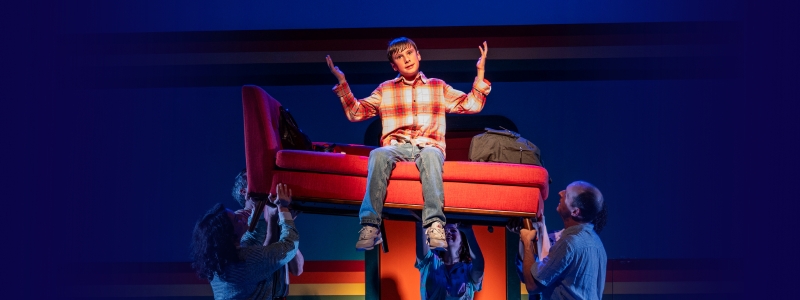Pre-Show Identity Activity

This activity guides students to consider the various identities they hold. In Falsettos, characters grapple with the way their identities brush up against, or come into conflict with, their families, their social circles, and society. Characters are Jewish, gay, straight, parents, chronically ill, only children, professionals, and athletes, among many other identities. Students may or may not have experience with these identities, and this activity will allow them to consider the common experiences that span diverse identity groups.
As always, please note that some steps of the activity may be condensed, eliminated, or extended based on the needs of your classroom.
This activity was developed in collaboration with The Living History Program at TimeLine Theatre Company.
Making a Home
Activity Preparation
- Supplies:
- Making a Home: Identity Map handout (one per student)
- Markers or colored pencils (optional)
- Set-Up:
- Note that elements of this activity invite students to be vulnerable. Encourage students to do so as it matches their comfort level, but do not insist that students share any information about themselves that they do not wish to share.
This activity will take approximately 50 minutes.
Learning Sequence
- Ask students to define the word identity. Once a few students have had the chance to share their ideas, read the definition aloud (~1 minute):
- Identity (n): the set of qualities, beliefs, personality traits, appearance, and/or expressions that characterize a person or a group.
- Ask students what surprises or jumps out to them in this definition. Point out the words “person” and “group,” and ask students about the significance of these words. (~5 minutes)
- Pass out the Making a Home: Identity Map handout. Review the identity categories with students, offering additional examples of each if necessary. Emphasize that there is no wrong answer for these categories. (~5 minutes)
- Gender: What is your sense of your gender?
- Race: How do you identify racially?
- Family: What family identities/relationships are significant to you?
- Sexuality: Who do you feel attraction towards?
- Religion: What religious or spiritual practice do you have?
- Social Class: What economic/income group do you identify with?
- Nationality: What is you/your family’s country of origin?
- Disability: What (dis)abilities do you have?
- Age: What age group do you fall in?
- Culture: What beliefs, values, and practices do you share with others?
- Personality: What characteristics most define you?
- Zodiac: What is your sun, moon, and rising sign?
- Birth Order: What order are you born into amongst your siblings?
- Language: What is your home language or second language?
- Talents: What are you really good at?
- Activities: How do you choose to spend your time?
- Guide students to write down what identity they feel most fits them for ten of the categories on the handout. Please do not insist that or require students to complete all 16, though they may choose to. Students may have a variety of comfort levels around these topics, some of which may be sensitive. Students should be allowed to share only what they wish to. (~10 minutes)
- Direct students to the heart diagram on their handout. Have them write some – or all – of their identities inside the heart, drawing them as artistically as they desire, using markers or colored pencils, as available. They may choose to treat the diagram like a word cloud, with more personally significant identities written larger than others. (~10 minutes)
- Invite students to reflect in writing on the back of their handout. (~5 minutes)
- As time allows, facilitate a discussion with the class on identities. Pose the following questions. (~10 minutes)
- How can identities create unity and community?
- How are identities used for isolation and separation?
- How does it feel to be seen for all of your identities?
- This activity aligns with the following standards:
- Illinois Arts Learning Standards
- Anchor Standard 1: Generate and conceptualize artistic ideas and work.
- Anchor Standard 10: Synthesize and relate knowledge and personal experiences to make art.
- Common Core State Standards
- CCSS.ELA.R.3: Analyze how and why individuals, events, or ideas develop and interact over the course of a text.
- CCSS.ELA-Literacy.CCRA.W.4: Produce clear and coherent writing in which the development, organization, and style are appropriate to task, purpose, and audience.
- Illinois Arts Learning Standards